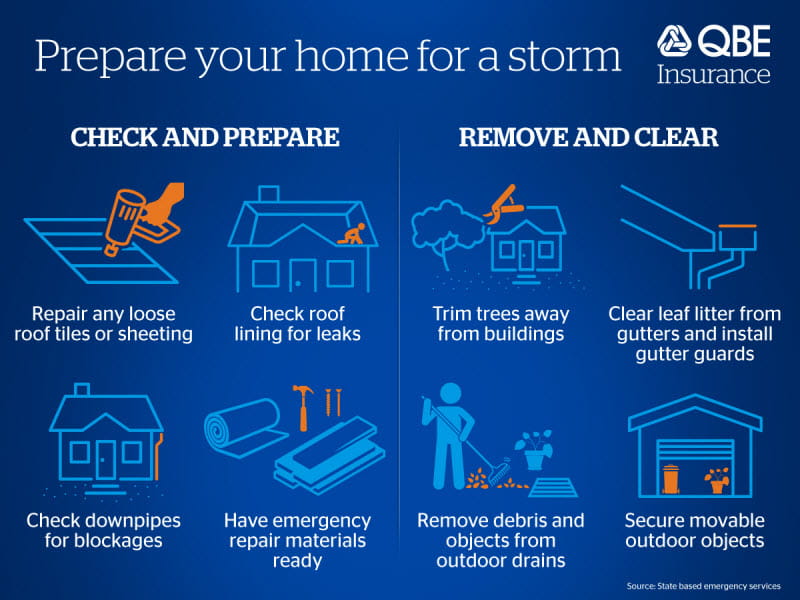How to prepare for a storm
This article was originally published in October 2021 and was updated in January 2025.
- Storms are one of Australia’s most frequent natural hazards, with almost 3,000 recorded in the last 10 years1
- The peak period for severe storms is October to March, but storms can occur anytime, including when you’re not at home
- Taking five key steps can minimise storm damage and help you ride out the worst of the weather
Australia is no stranger to wild weather, and storms top the list of our most frequent major natural hazards.
That’s why it’s important to know how to prepare for a storm when a weather alert is issued by the relevant authorities. A few steps taken early on can help protect you, your home and your belongings.
Australian storm facts
Severe storms hit Australia with surprising frequency. Between 2014 and 2024, the Bureau of Meteorology (BOM) recorded almost 3,000 severe storms, which is an average of almost 300 storms annually.2
While the peak thunderstorm period is October to March, severe storms can occur any time. One of Australia’s most costly thunderstorms hit the eastern suburbs of Sydney in April 1999, causing $1.7 billion in insurance claims – a figure that would rise to $3.34 billion today.3
Storm damage can arise from multiple factors – not just heavy rainfall, but also hail, lightning, strong winds and flash flooding. A good storm safety plan should address all these possibilities, so you’re storm-ready before danger strikes.
5 storm preparation tips
Wild weather can hit fast, so it makes sense to have your storm safety plan in place long before dark clouds start rolling over the horizon. Here are five steps that may help you stay safe during storm season.
1. Keep gutters, downpipes and drains clean
Leaves and other debris can build up in gutters, blocking downpipes during heavy rainfall. Overflowing water can damage your home’s foundations, tear gutters from roofs and lead to mould and structural damage.
Prevent this happening by regularly cleaning out gutters. It’s also a chance to check for missing roof tiles or loose cladding that could break away in high winds.
2. Trim overhanging tree branches
Maintaining trees surrounding your property can prevent damage caused by falling branches and boughs – or even uprooted trees.
Check local council guidelines for trimming trees – and leave big jobs to the professionals. Calling in a qualified tree surgeon can be a far safer option than tackling the task yourself.
3. Secure any loose items
Severe storms can be accompanied by wind gusts more than 90 kilometres per hour, turning everyday objects like garden furniture into dangerous projectiles. Trampolines, for example, are frequently captured flying through the air in storms,4 with authorities regularly reminding owners to ensure they’re secured before a storm hits.5
Remember, storms can hit while you’re not at home, so aim to keep outdoor areas tidy, and secure or stow away items likely to be picked up by strong winds, rather than leaving them out in the open.
4. Have an emergency storm kit
Storms can leave you without power and water, potentially for days. Having an emergency kit ready can help you get by until services are restored.
Your storm kit should include medications, a torch and portable radio, spare batteries, first-aid kit, supplies of food and drinking water, blankets and clothing. It can also include important documents stored in waterproof containers.
5. Stay safe as the storm approaches
As the storm draws closer, close doors and windows and bring pets inside. Unplug electrical appliances and aerials and switch appliances off at the circuit board.
Storms often pass quickly, and it can be tempting to watch the action but it’s best to stay away from windows in case of flying debris. Instead, monitor the radio or internet for local weather updates.
Tips to help reduce the risk of lightning strikes
- Always use appropriately recommended surge protection outlets throughout your house.
- If your home is in an exposed location, consider installing a lightning protection system and an emergency backup power source.
Tips to help reduce the risk of strong winds
- Perform regular maintenance on tile or sheet cladding to avoid parts of your roof lifting off.
- Fit windows and skylights with security mesh or durable insect screens along with storm shutters if necessary.
- Plant trees to form a windbreak on rural properties, ensuring trees are a safe distance from your home.

State-by-state storm warning information
The BOM issues severe thunderstorm warnings on social media. Regularly check the BOM website or for automated weather warnings for all states and territories, call 1300 659 210.
If you’ve been impacted by a major storm and need help, the number for State Emergency Services is the same across all states and territories – call 132 500. Here are links to state-based emergency services:
- Queensland
- New South Wales
- ACT
- Victoria
- Tasmania
- South Australia
- Western Australia
- Northern Territory
When did you last check your home and contents cover?
Australia’s high level of storm activity makes it important to have up-to-date home insurance, or contents insurance if you’re renting.
The good news is that when you have QBE Home Insurance or QBE Contents Insurance, you don’t need to worry about insurance paperwork getting damaged in a storm. All we need is your name and phone number to get the ball rolling if you need to make a claim.
1 Severe Storms Archive | Bureau of Meteorology (BOM)
2 Severe Storms Archive | Bureau of Meteorology (BOM)
3 Inflation Calculator | Reserve Bank of Australia (RBA)
4 Strong winds blew a trampoline into one Melbourne resident’s backyard | ABC News
5 Minimise storm damage in Illawarra: SES' eight tips to stay safe | Illawarra Mercury | Wollongong, NSW











